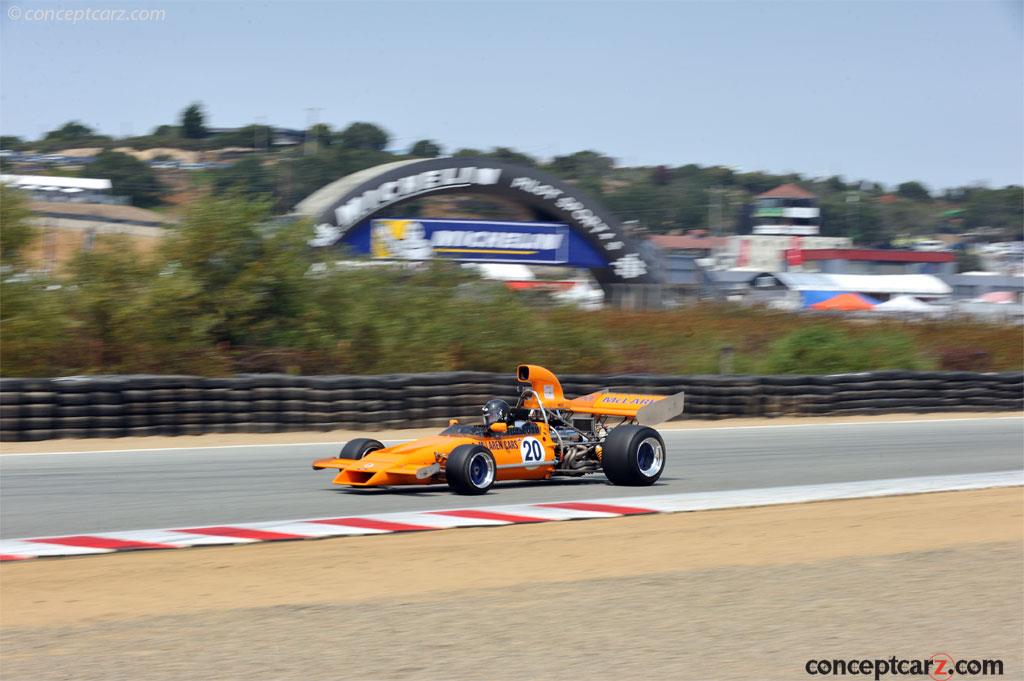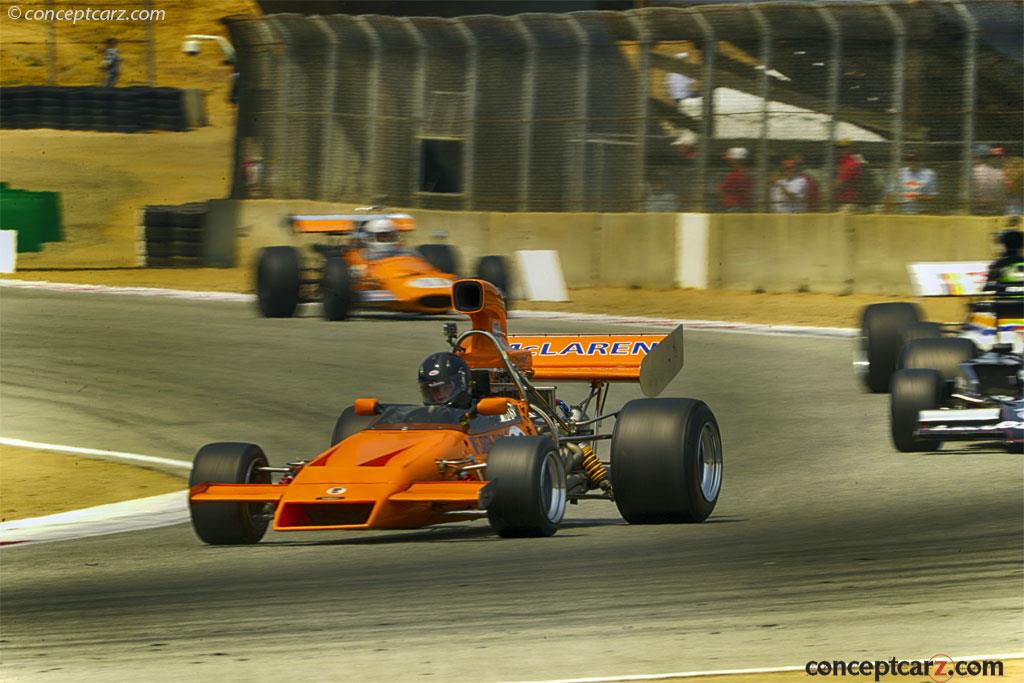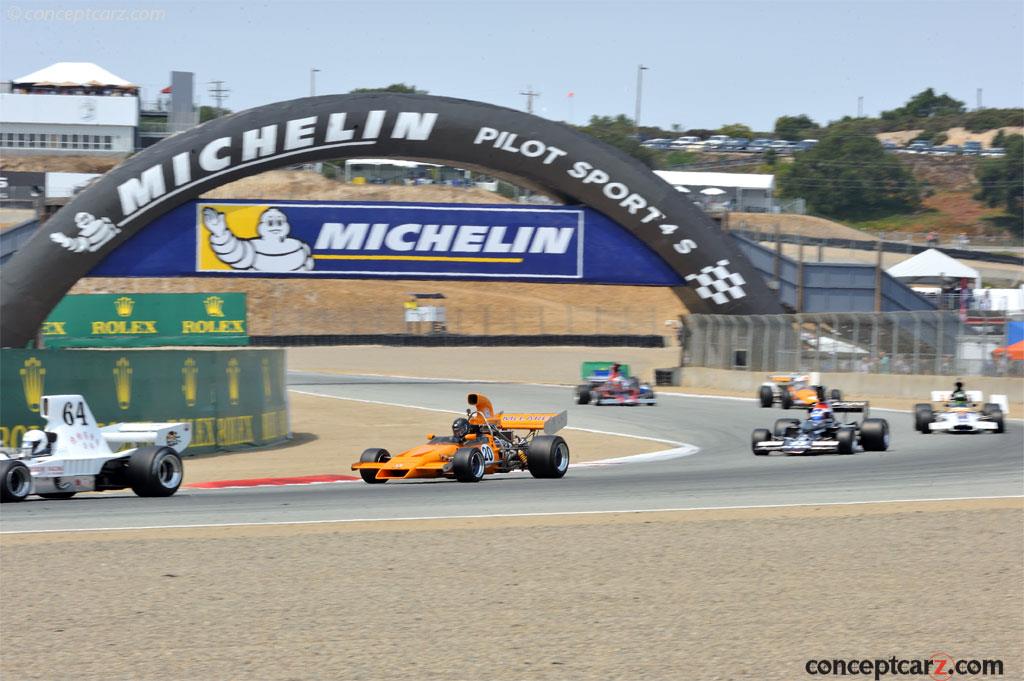During the mid-1960s, there were several options for open-wheel, single-seat racing. However, they had either become too crowded or too expensive. So another racing formula was added. For the American market, the Sports Car Club of America modified their Formula A to allow for engine capacities up to five liters. This resulted in the Formula 5000 (5000 represented engine displacement) racing series which lasted from 1968 to 1982. 
Racer
Chassis #: M22-3-72
View info and historyBruce McLaren, a racer who was also technically competent, assembled a team of talented individuals to help with the racing endeavors, including Formula 1 and Can-Am. McLaren worked together with Robin Herd to design the Can-Am winning M6. Confident with Herd's abilities, McLaren tasked Herb with designing a new Formula 1 car for the team. Departing from the normal fully enclosed chassis design like the one used on the Lotus 49, Herd instead chose a bathtub-style monocoque chassis. Rubber fuel tank bladders were placed on either side of the driver to help maintain a lower center of gravity and assist with forward and aft stability. Unfortunately for McLaren, Herd was lured away by Coworth, leaving Bruce back in charge of the M7A project. Bruce continued Herd's overall design and tasked Gordon Coppuck to work on the car's suspension. The Can-Am series certainly influenced the M7A's design, being given a rather pointed nose and low profile oval-shaped radiator opening for the high-speed venues. For courses like Monaco, where cooling was of greater importance, a rounder, larger radiator was adapted in the nose. Mounted behind the driver was a 430 horsepower Cosworth V8 mated to a Hewland 5-speed manual gearbox. Ventilated disc brakes were located at all four wheels and steering was handled by a rack-and-pinion setup. In just the car's third race, it would achieve victory in the Belgian Grand Prix with Bruce McLaren at the wheel. This would be followed up with Denny Hulme scoring back-to-back victories in the ninth and tenth rounds of the 1968 season.
Racer
Chassis #: M22-3-72
View info and historyMcLaren's first Formula 5000 car was based on the successful M7A Formula 1 car. Perhaps the biggest changes Coppuck made were necessitated by the Chevrolet 5-liter V8 engine. It had an extended monocoque chassis and a sophisticated suspension setup and an aerodynamic body. The wheelbase measured 97.5 inches and the chassis was paneled in light-alloy sheet, bonded and riveted to fabricate steel bulkheads. Additional rear pontoons supported the engine and gearbox, in contrast to the F1 M7 design in which the DFV engine doubled as the load-bearing rear chassis structure.In the front were wishbones and coil-over shocks. Lower wishbones, top links, twin radius rods and coil-overs were used in the back. Braking was handled by 12-inch diameter Lockheed discs. The car was called the M10A and was built by Trojan. A total of seventeen examples were built and most were sent to America, with just one staying in the United Kingdom and raced by Peter Gethin. Gethin would win the Guards 5000 Championship that year with the McLaren. The McLaren M10A won the SCCA national title in Formula A and dominated the first season of F5000 racing in Europe. 
Racer
Chassis #: M22-3-72
View info and historyNext came the McLaren M10B, a further development of the M10A. A total of 24 examples were built in period. Among the changes was the engine being lowered into the chassis by two inches. Again, the McLaren won the European Formula 5000 championships. McLaren replaced the M10B in 1972 with the M18. It did not achieve the same success as the prior models. Brian Redman drove the Works M18 during the 1972 season, securing two victories from sixteen starts. While the M22 was in development, the M18 was updated with an improved rear suspension and handed to David Hobbs to race in the Tasman series. It was called the M18/22. When the M22 was officially introduced, it was more of an updated M18 rather than being based on the M19 Formula 1 car. It had a McLaren F2-style nose, larger 13-inch rear wheels, and changes to the front suspension. By this point in history, McLaren was focusing on Formula 1, Indy, and Can-Am. With little interest or support from the Works team, their partner Trojan stopped making F5000 cars late in 1972.
by Daniel Vaughan | May 2019

Racer
Chassis #: M22-3-72
View info and history

Racer
Chassis #: M22-3-72
View info and history

Racer
Chassis #: M22-3-72
View info and history
by Daniel Vaughan | May 2019
1972 McLaren M22 Vehicle Profiles
Recent Vehicle Additions
Related Automotive News

WORLD-FIRST DISPLAY OF ALL SEVEN REMAINING LOTUS 49S LINING-UP AT AUTOSPORT INTERNATIONAL
Autosport International to host display featuring all seven remaining Lotus type 49 cars thanks to their owners from around the world
Celebrations at Autosport International to mark 50 years since this pioneering F1 car first raced
To this day, th...
Vintage Racers Decend on Road America for The WeatherTech International Challenge With Brian Redman Presented by HAWK
- Mid-Summer Vintage Event Recalls a Sensational Era of Racing -
ELKHART LAKE, Wis., July 12, 2016 - Summer is in full swing and this year hundreds of vintage racers will make the journey to Elkhart Lake, Wisconsin to celebrate the beauty...
RRDC VOTES IN 37 NEW MEMBERS FOR 2013
HILLIARD, Ohio (Nov. 7, 2013) - Thirty-seven race-car drivers and motorsports professionals have been voted into the Road Racing Drivers Club in 2013. The group includes 13 Regular Members from the open-wheel and sports-car racing ranks, 20 Associate...
RACE FOR HUNTINGTON'S DISEASE RESEARCH BACKED BY AC/DC'S BRIAN JOHNSON AND CHAMPION DRIVERS AT SEBRING
SEBRING, Fla. (Oct. 11, 2013) - Seven champion race-car drivers and one rock star racer will compete in a Porsche 935 JLP HD1 on Dec. 8, 2013, in Sebring, Fla., to help raise funds and awareness for Huntingtons Disease (HD). The 4-hour endurance...

1968 Belgian Grand Prix: A First for McLaren
McLaren and Formula One are truly synonymous. Over the course of its history, McLaren has completed 714 races and have garnered no less than 178 victories. But while McLaren and victory in Formula One are an almost certainty, the very first would be...













